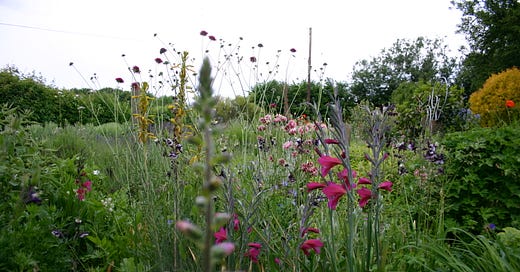A brief note on Ego or Eco design
Garden design and landscaping have arguably always been about ego. Look at me and my rolling acres, my prized slice of fashionable paradise on earth and so on. Perhaps that is why I often find the relationship between garden design and even so-called eco or environmental implementation troubling. While there are of course plenty of wonderful sensitive designers, unfortunately too often even exponents of designing with nature seem to impose their interpretation on to the ground they are working with, rather than working with that ground. The result may be something that has little to do with natural systems or processes, something that represents nature only in justification.
Somewhere, at some point, a tendency seems to have risen to forget or ignore the fact that we are part of nature and nature is part of us. Good design needs to integrate the needs and desires of nature, the wider environment, the future, and the gardener. Once the idea of A Sense of Place was at the forefront but It doesn’t seem a fashionable concept although it anchors a garden and its plants firmly to its locality and its environment. I’m sure it’s fascinating to experiment growing in different soils and materials that aren’t necessarily part of your local ecosystem, to see just what will grow, what could be possible in different circumstances but how does that fit with ecology or the need to support local plant communities for sustainability and plant security? On a slightly less extreme level, but in similar vein is a response to climate change where designers and gardeners advocate planting Mediterranean plants or those from drier or hotter shores. We have all seen show gardens celebrating gardens of the future with dozens of these interlopers, as well as those exhibiting ranges of plants growing on rubble and debris, but surely we should be trying to hang on for dear life to our native plants in their own changing habitats, treasuring them and encouraging them to thrive and adapt to changing times.
Did nature become something external when the “great” landscapers of the 17th century started to tame and change it for their wealthy clients, or is it more recent? We should have progressed far beyond the need to show off so obviously, but the gardens of the rich and powerful still reach out tantalising tentacles encouraging new approaches - with others selectively photographed and drooled over on social media adding to the mix. The extraordinary and influential rewilding project at Krepp has arguably done nature a huge service by sparking huge debate and showing the vital importance of regenerating an environment systematically depleted by misguided agricultural practises. Whether eco wins over ego here is however debatable, and along with the great power and publicity of this poster project has come the (presumably unintended) possibility of great misinterpretation. The whole rewilding debate has thrown huge confusion as well as potential into the garden design arena and the basic question of ecological design. The best thing about Knepp is that nature was the starting point, however that has been realised, and there is arguably always a need for showcases even though they inevitably involve most observers only viewing nature from afar rather than being immersed in it. But attempts to keep the brand going and transpose it into smaller spaces has inevitably meant much has got lost in translation, and frustration at attempting to follow rewilding ideas in smaller or less suitable spaces can mean that the eco message gets lost. Luckily Repton didn’t have social media driving his ideas on, it’s hard to imagine how his theories would have been interpreted by lower class mortals eager to jump on the bandwagon.
I always have an issue with the hard landscaping aspects of garden design - though it’s impossible to argue against good paths and access – as I’m much more interested in the plants and the way they develop. Designers may justify environmentally sourced materials, but most hard landscaping entails a lot of cement and a lot to get rid of later on if a garden changes hands or design desires develop. Perhaps this is just a personal obsession as I have moved gardens more than once, but I think minimal hard landscaping should be a prerequisite of any eco garden. Surely an eco garden should gently continue to grow into itself, boundaries should blur, some species will take over, but the spirit of the garden will remain. There may be a few paths and structures that will either be maintained or gently crumble and decay into disarray, but they will not remain dominant.
But then, I probably favour gentle decay over organised maintenance, there are stories in that decay, stories from nature and developing and changing plant communities as well as history from the gardener. (And I am at an age where gentle decay is inevitable so worth embracing rather than battling against!)
We are part of nature, and this relationship should be critical and central to good eco/environmental garden/landscape design. If we could take the ego out of gardening, our environment would be much the better for it.




